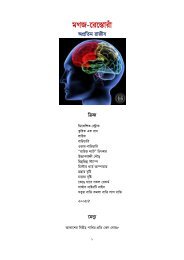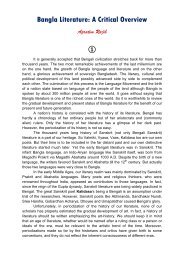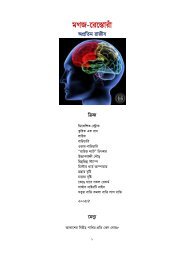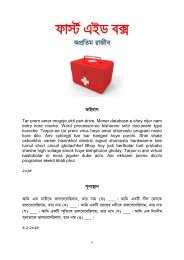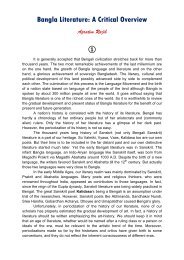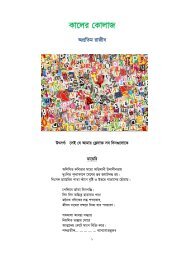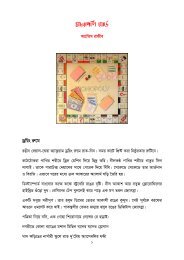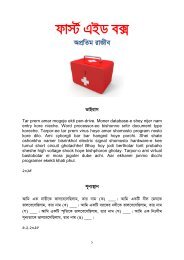BLiterature-Apratim
Create successful ePaper yourself
Turn your PDF publications into a flip-book with our unique Google optimized e-Paper software.
6<br />
Charitamrita is a poetic gift and historically remarkable. Brindabandas’s Chaitanya-<br />
Bhagabat is a well-reliable work on Chaitanya’s life and contemporary Bengal.<br />
The Vaishnava poets saw him from very close distance. They comprehended<br />
his mystic doctrines and greatness of his life-story. The hagiographers and Padapoets<br />
drew their guru’s life-sketches and images like class painters. He influenced<br />
the whole Bhakti movement of India, which he himself had initiated. The<br />
contemporary poets glorified Chaitanya’s life what Jayadeva had done for Krishna. In<br />
this context, two lines from Sree-Chaitanya-Charitamrita are notable: Vishnu (of who<br />
Chaitanya is recognized an ‘incarnation’) made an oath in heaven –<br />
“I shall descend on the earth for having three tastes<br />
Having the complexion and appearance of Radha.”<br />
(Translated by the author)<br />
And his intention, as the poet says, is to know the madness of Radha’s love<br />
for her divine lover. The message is that one gets salvation if one loves God like a<br />
true lover. And Chaitanya is, to his followers, a ‘fusion incarnation’ of Krishna and<br />
Radha in a single body.<br />
The poets influenced by Chaitanya’s philosophy also made an analogy<br />
between love and lust – lust is the sexual impulse for another living being while love<br />
is such one for Krishna.<br />
Chaitanya declared that there is no caste-divide for the worship of Krishna;<br />
Brindabandas recalls his word in Chaitanya-Bhagabat –<br />
“An untouchable is no untouchable, if he calls ‘Krishna’,<br />
A Brahmin is no Brahmin, if he walks along sinful path,<br />
Whoever worships, is the devotee, a heretic is a mean damned,<br />
Neither caste nor creed Krishna-puja demands.”<br />
(Translated by the author)<br />
Chaitanya gave a sharp conception of the depth of mystic love. In order to<br />
glorify his godlike guru, Krishnadas says –<br />
“He is the main dancer, all the rest are co-dancers;<br />
Everyone dances in the way he wishes.”<br />
(Translated by the author)<br />
However, these are just conceptions of the Middle Ages and quite archaic<br />
now.<br />
Nevertheless, the inner richness, ornamental language and astonishing<br />
philosophy of Vaishnava literature are eligible to be compared to the classics of<br />
world literature.<br />
The period was influenced by Chaitanya in mainly four ways –<br />
1. Vaishnava Padas conveyed his mystic ideas,<br />
2. Vaishnava Padas even about him were composed,<br />
3. A new genre – hagiography was created centering his life, and<br />
4. Verse-fictions (actually Mangal-Kabyas) having humanistic ideas were<br />
written.<br />
Vaishnava Pada-literature reached its peak in this period. The greatest poet of<br />
this genre is Chandidas. Unlike others of the era, his Padas are rich in witty words<br />
and attractive naivety. His historicity is untraced and therefore, I include him in




